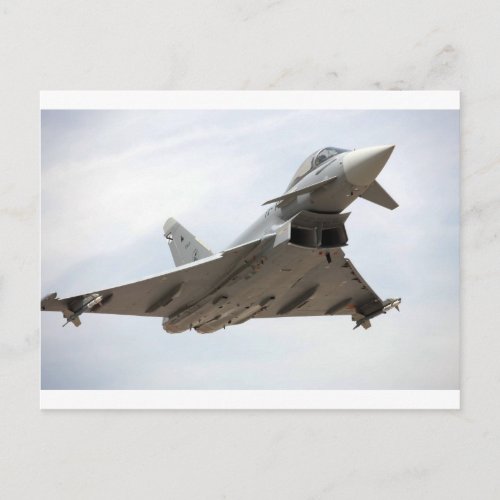EUROFIGHTER TYPHOON POSTCARD



EUROFIGHTER Brakes off to 35,000ft / M1.5 < 2.5="" minutes="" brakes="" off="" to="" lift="" off=""><8 seconds (Full Internals and Missiles) At low level, 200Kts to Mach 1 30 seconds Supercruise capability and Dry Power Acceleration from Sub to >Supersonic -- Eurofighter Typhoon has a foreplane/delta configuration which is, by nature, aerodynamically unstable. The instability of the aircraft is derived from the position of a theoretical “pressure point” on the longitudinal axis of the aircraft. This is calculated from the contribution to lift from each of the aircraft components (the wings, the canards, fuselage etc). If the pressure point is in front of the centre of gravity on the longitudinal axis, the aircraft is aerodynamically unstable and it is impossible for a human to control it. Eurofighter Typhoon banking with afterburners With the Eurofighter Typhoon, in subsonic flight the pressure point lies in front of the centre of gravity, therefore making the aircraft aerodynamically unstable, and is why Eurofighter Typhoon has such a complex Flight Control System – computers react quicker than a pilot. When Eurofighter Typhoon crosses into supersonic flight, the pressure point moves behind the centre of gravity, giving a stable aircraft. The advantages of an intentionally unstable design over that of a stable arrangement include greater agility – particularly at subsonic speeds - reduced drag, and an overall increase in lift (also enhancing STOL performance). Eurofighter Typhoon has a foreplane/delta configuration which is, by nature, aerodynamically unstable. The instability of the aircraft is derived from the position of a theoretical “pressure point” on the longitudinal axis of the aircraft. This is calculated from the contribution to lift from each of the aircraft components (the wings, the canards, fuselage etc). If the pressure point is in front of the centre of gravity on the longitudinal axis, the aircraft is aerodynamically unstable and it is impossible for a human to control it. Eurofighter Typhoon banking with afterburners With the Eurofighter Typhoon, in subsonic flight the pressure point lies in front of the centre of gravity, therefore making the aircraft aerodynamically unstable, and is why Eurofighter Typhoon has such a complex Flight Control System – computers react quicker than a pilot. When Eurofighter Typhoon crosses into supersonic flight, the pressure point moves behind the centre of gravity, giving a stable aircraft. The advantages of an intentionally unstable design over that of a stable arrangement include greater agility – particularly at subsonic speeds - reduced drag, and an overall increase in lift (also enhancing STOL performance). Sensor fusion is the processing of information received and transmitted by the key aircraft sensors. This information is presented to the pilot clearly and accurately, in an uncluttered fashion, to allow for safe and efficient single seat operation in the swing-role environment. The high level of integration and sharing of information between the various sub-systems gives the pilot an autonomous ability to assess rapidly the overall tactical situation and respond efficiently to identified threats. The Eurofighter Typhoon autopilot is designed for both long range cruising and to assist the pilot in tactical situations. The autopilot provides basic track, heading, altitude and airspeed modes, and allows the pilot to fly optimum attack profiles automatically. Advanced modes such as auto-climb, auto-attack, and auto-approach are available. The autopilot is an integrated part of the pilot's tactical control.


